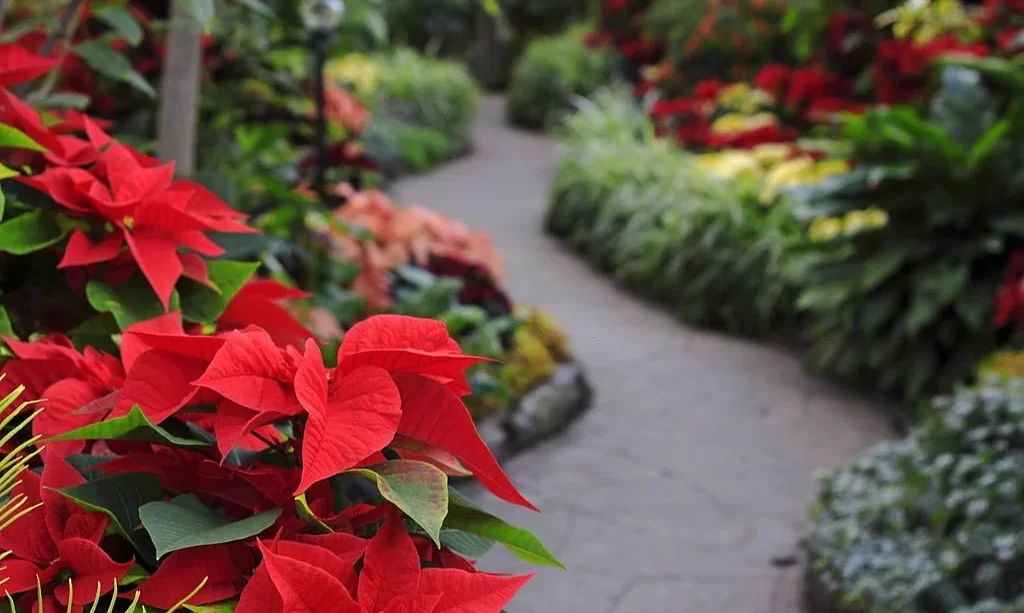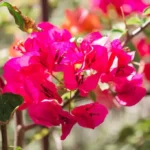Poinsettias, with their vibrant red and green foliage, are iconic symbols of the holiday season. But what many people may not realize is that these festive plants have the potential to thrive beyond the winter months. In this article, we will explore the intriguing question: “Can Poinsettias Live Outside in the Summer?” While we often associate them with cozy indoor decor during Christmas, understanding poinsettias’ origins and characteristics is the first step in unraveling the mystery of their suitability for outdoor living. So, let’s dive into the world of poinsettias and discover what makes them tick.
- Beautiful true traditional Poinsettia Plant – 4″ pot in basket
- Thoughtful gifts
Poinsettias
To understand whether poinsettias can flourish outdoors in the summer, it’s essential to get to know these unique plants. Poinsettias, scientifically known as Euphorbia pulcherrima, are native to Mexico and Central America, where they can grow as large shrubs or small trees in their natural habitat. The name “poinsettia” comes from Joel Poinsett, the first U.S. Ambassador to Mexico, who introduced the plant to the United States in the early 19th century.
Poinsettias are famed for their colorful bracts, which are often mistaken for flowers. These bracts, typically red, but also available in shades of pink, white, and even marbled patterns, surround the inconspicuous yellow flowers at their centers. These showy bracts are what make poinsettias so captivating and well-suited for holiday decorations.
Stay with us as we delve deeper into the characteristics of poinsettias and explore whether they can thrive outdoors during the summer months.
Poinsettias Indoors
For many of us, poinsettias are synonymous with indoor holiday decor. These plants have become cherished centerpieces during the festive season due to their striking appearance and rich symbolism. Indoors, poinsettias thrive in controlled environments with consistent temperatures ranging from 65 to 75 degrees Fahrenheit (18 to 24 degrees Celsius). They prefer bright, indirect sunlight and should be placed where they won’t experience drafts or sudden temperature fluctuations.
One reason poinsettias have become indoor favorites is their sensitivity to cold temperatures. Even a brief exposure to chilly air can harm these tropical plants. Additionally, poinsettias need regular watering, but they don’t like to sit in soggy soil, so ensure proper drainage in their pots. During the holiday season, they bring joy and festive spirit to our homes, making them a cherished tradition. But can they venture outdoors? Let’s find out in the next section.
- 22″ Lifelike Artificial Potted Poinsettia Plant
- Comes in a decorative metallic green foil wrapped pot with Decorative red bow.
- Christmas Decoration
- Red
- Plant is 22″ high
Poinsettias Outdoors
The prospect of poinsettias basking in the summer sun might seem appealing, but it’s crucial to consider their natural habitat. Poinsettias originate from regions with warm climates, and they have adapted to thrive in specific conditions. In their native Mexico and Central America, they grow in well-draining, slightly acidic soil under the bright, tropical sun. These conditions are quite different from the temperate climates many of us experience during the summer months.
To successfully place poinsettias outdoors, we must replicate their natural habitat as closely as possible. This includes providing the right temperature, sunlight, and care. While it’s possible to enjoy these beautiful plants outside, certain precautions and preparations are necessary to ensure they not only survive but thrive during the summer. We’ll explore these preparations in the next section on preparing poinsettias for outdoor living.
Preparing Poinsettias for Outdoor Living
Transitioning poinsettias from the cozy indoors to the great outdoors requires careful planning and preparation. The sudden change in environment can shock these plants, potentially causing stress or damage. To avoid this, it’s essential to follow a step-by-step process.
First, choose an appropriate location for your poinsettias outside. They prefer a spot with morning sun and afternoon shade to mimic their native habitat. Ensure the chosen area has well-draining soil, as poinsettias dislike standing water.
Before making the move, gradually acclimate your poinsettias to outdoor conditions. Start by placing them outside for short periods, gradually increasing the time over a week or two. This helps them adjust to the new environment without experiencing shock.
Re-potting may also be necessary if your poinsettias have outgrown their indoor containers. Use a well-draining potting mix that suits their needs.
In the summer months, keep a watchful eye on their watering needs. Poinsettias prefer consistently moist soil but not waterlogged conditions. Regularly check the soil moisture and water when the top inch feels dry to the touch.
By taking these careful steps and providing the right conditions, you can prepare your poinsettias for outdoor living and increase their chances of thriving during the summer.
Caring for Poinsettias Outdoors
Once your poinsettias have transitioned to the great outdoors, their care requirements change compared to their indoor life. Outdoors, they benefit from the natural elements, but they still need your attention. Here’s how to care for poinsettias during their summer sojourn:
- Watering: Outdoor poinsettias often need more water than their indoor counterparts. However, it’s essential to maintain consistent moisture levels without overwatering. Aim for deep, thorough watering, allowing the soil to dry slightly between waterings.
- Sunlight: Place your poinsettias in a location where they receive morning sunlight and some afternoon shade. Too much direct sun can scorch their leaves, while insufficient light may lead to leggy growth.
- Fertilization: Feed your outdoor poinsettias with a balanced, slow-release fertilizer every 4-6 weeks during the growing season. Avoid excessive nitrogen, as this can lead to excessive leaf growth at the expense of bract formation.
- Pruning: Pinch back the new growth tips to encourage bushier, fuller plants. This can help create a more compact and attractive appearance.
- Pest and Disease Management: Keep an eye out for common garden pests like aphids or whiteflies, and treat them promptly if they appear. Also, watch for signs of disease and address any issues promptly to prevent the spread.
Remember that poinsettias outdoors are more exposed to the elements, so you’ll need to be vigilant in providing them with the care they require. Now, let’s explore what happens when summer fades and it’s time to bring these plants back indoors.
- Professional Liquid Fertilizer for: Poinsettia varieties (Euphorbia pulcherrima)
- This food for plants belongs to the latest generation of fertilizers, for healthy leaves, stable and strong formation, balanced rooting, beautiful flowers.
- Very rapid effects, can be administered via the roots and as a foliar fertilizer. For 60-125 liters of ready to use liquid fertilizer
- Content: 250 ml, works as an economical concentrate. Simple dosage with the help of the cap.
- The fertilizers from the GREEN24 PROFI LINE were developed by gardeners of various departments and were evolved and produced based on the current knowledge in the field of propagation and cultivation of plants.
Poinsettias Indoors Again
As summer turns to fall and the weather begins to cool, it’s crucial to think about returning your poinsettias indoors. This transition is especially important if you want your poinsettias to rebloom for the holiday season. Here’s what you should do:
- Timing: Begin the transition in early fall before nighttime temperatures drop below 50°F (10°C).
- Gradual Acclimatization: Just as you did when moving them outdoors, reintroduce your poinsettias to indoor conditions gradually. Start by bringing them indoors for a few hours each day, then increase the indoor time over a week or two.
- Indoor Care: Place your poinsettias in a bright spot with indirect sunlight. Maintain a consistent indoor temperature of around 65 to 75°F (18 to 24°C).
- Reduced Watering: Poinsettias may require less water indoors during their dormant period. Let the soil dry slightly between waterings to prevent overwatering.
By following these steps, you can help your poinsettias adjust to their indoor environment and potentially encourage them to rebloom in time for the holiday season.
Conclusion
In the journey to answer the question, “Can Poinsettias Live Outside in the Summer?” we’ve discovered that while these holiday beauties are primarily associated with indoor holiday decor, they can indeed spend the summer outdoors with proper care and attention. The key is to provide them with conditions that mimic their native habitat, including well-draining soil, the right amount of sunlight, and consistent watering.
However, it’s essential to remember that poinsettias are sensitive to temperature fluctuations, so transitioning them both outdoors and back indoors should be done gradually to avoid stress. Whether they thrive outdoors or grace your indoor holiday displays, poinsettias can bring color and cheer to your garden and home throughout the year with the right care and knowledge. So, with the proper precautions and care, you can enjoy the beauty of poinsettias both inside and outside your home.






